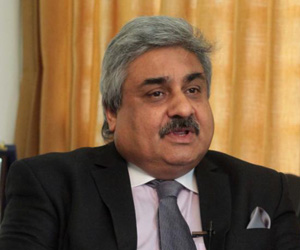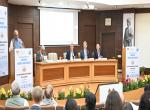The Strategic Partnership between India and EU was forged in 2004. The precursor to this partnership was a Joint Political Statement (1993) and a cooperation Agreement (1994)both of which laid the basis of this partnership. India and EU also agreed on a Joint Action Plan in 2005 which was later upgraded in 2008 when the two sides decided to expand their cooperation in the fields of nuclear energy and environmental protection and deepen this strategic partnership. The 15th Summit between India and EU finally took place after a gap of two years on 15 July 2020 between Indian Prime Minister Modi and President of the European Council Charles Michel as well as the President of the European Commission Ursula von der Leyen. Besides the customary Joint Statement, the Summit produced some other key documents: the ‘EU-India Strategic Partnership: A Roadmap to 2035”, an “EU- India joint declaration on resource efficiency and circular economy”, a pact on research and development in civil nuclear energy, and a five year renewal for the science and technology cooperation agreement - which are all rich in content, and provide the direction on cooperation in a range of issues. The joint statement affirmed the determination of the two sides to promote “effective multilateralism and a rule – based multilateral order with the United Nations and the World Trade organization as its core”.
The roadmap to 2035 document spans economics, investment and trade, scientific research and innovation in cutting edge fields, student exchanges, movement of workers and citizens across borders, building modern societies, development in a sustained manner as well as basic tenets related to governance at the global level.
The two sides also agreed to reactivate their human rights dialogue. The protests against the Indian Citizenship Act which has been raised in the European Parliament figured in the discussions.
India and EU had launched talks for a wide-ranging Bilateral Trade and Investment Agreement (BTIA) encompassing trade in goods, services and investments in 2007, but the talks stalled in 2013 over differences on market access and movement of professionals. EU is India’s largest trading partner while India is the EU’s ninth largest trading partner with bilateral trade in goods touching $115 billion. Trade in services was estimated at $40 billion. The EU has cumulatively invested US$91 billion in India. There was agreement at the Summit to launch a high – level trade dialogue between the EU Trade Commissioner and India’s Commerce Minister to foster progress on ‘balanced, ambitious, and mutually beneficial’ trade and investment agreements, opening markets , creating a level playing field on both sides, addressing trade irritants and discussing supply chain linkages.
There are a number of contentious issues surrounding the abovementionedissues between the two sides. The EU has some key demands - including India’s import tariffs on automobiles and wines, opening up the services sector for European companies, andchange in rules guiding government procurement. India’s policy of “Atmanirbhar Bharat’ has raised concerns of protectionism in the European Commission bureaucracy. EU investments in India are crucial for India to realize its goal of raising the share ofmanufacturing in its GDP, and diversifying value chains, thereby lessening dependence on China. PM Modi therefore took care to clarify that the “Atmanirbhar Bharat “campaign was aimed at integrating domestic production with global supply chains and Europe in fact, could take advantage of this campaign and look to enhance its investments into India. There is no time frame set for the conclusion of the BTIA, but both sides have agreed that the two ministers mandated to take the discussions forward will meet as early as possible. It is important that these negotiations start as early as possible and both sides shed preconceived notions of each other’s stance in the past.
The Euratom Atomic Energy Community (Euratom) and the Department of Atomic Energy of India have agreed on a civil nuclear cooperation Agreement. The fields which will benefit range from nuclear safety to healthcare, agriculture to radioactive waste, and industry to fusion technology and nuclear safety. Through the document on circular economy and efficient use of resources, India and EU will now cooperate in efficient use energy, management of waste, information and communication technology, textiles, food and construction. Pure air and management of water are the new agreed areas.
India and EU will work together on space science and navigation as well as earth observation trough a specially set up joint working group. They will together develop post 2020 global frameworks on biodiversity and international waste and chemical management. Signaling enhanced cooperation between the Indian Navy and the EU naval force Atalanta the two sides have launched a new maritime security dialogue. There will be consultations on crisis management, as well as counter piracy operations in the Western Indian Ocean. This will enhance defence and security ties. India China relations and the situation on the border also figured in the discussions.
India’s Central Bureau of Investigation (CBI) and Europol have launched negotiations to combat organized crime and terrorism, and both sides have decided to intensify cooperation to tackle terror and its financing, radicalization and abuse of the internet for such activities. Pakistan came up for discussion in the context of activities it has been continuing against India and other countries in the region as well as in the context of global terrorism.
Biotechnology, clean energy e mobility , energy efficiency and bio sciences exchanges will all benefit, given that the science and technology agreement has been extended for another five years. PM Modi took this opportunity to welcome EU investments and technology in India’s push towards renewable energy. The cooperation on climate change and a dialogue on the subject including the strengthening of the International Solar Alliance are areas of convergence between the two sides. The EU will hold a joint climate dialogue on solar and offshore wind resources with India. The EU raised the need to make tough choices such as phasing out coal, even as this comes against the background of India looking to increase its coal output inorder to become a net exporter of this commodity. The EU also looks forward to cooperating with the Coalition for Disaster Resilient Infrastructure (CDRI) launched by India.
A partnership in the health sector between India and EU will benefit both immensely. An agreement to work together on the Covid response and to develop universal and affordable vaccines as well as cooperate in production ofpharmaceuticals and related apparatus is timely. Cooperation in multilateral institutions, strengthening of multilateralism and working together during India’s Chairmanship at the WHO in 2020 and during its UNSC stint for the next row years will strengthen India’s hands. India must cooperate with EU in Information and Communication technology, in order to become self sufficient in the digital space and bring investments in emerging and cutting-edge technologies.
The EU offered to share its experience in data protection legislation as convergence of standards will facilitate data flows. The convergence on building global standards on 5G and Artificial Intelligence is a natural progression of the desire of both sides to foster their safe and ethical deployment and utilize talent available in Europe as well as India. India needs to develop its infrastructure. The EU provides Euro 414 billion of global aid, and its partnership with Japan and USA is seen as an alternative to BRI. The roadmap talks of exploring avenues to improve connectivity between EU and India, and seek synergies between their cooperation on connectivity with third countries including in the Indo pacific region. Indian metro, ports, highways and infrastructure as well as India projects in third countries will benefit from an India EU partnership.
The EU has grown conscious of Chinese aggressiveness in the Indo-Pacific. It is therefore laying stress on maritime domain awareness and information sharing in the region with strategic partners. India, Japan, Australia and the US can work with EU in order to check growing Chinese presence in this region. Individually, France,UK and Germany can all be useful strategic partners of the Quad countries.
By laying stress on freedom of navigation and openness in the Indian Ocean and the Pacific, the two sides have come together on the need to maintain stability, safety, security and peace in these global commons. The UNCLOS, and an inclusive approach in the maritime domain for full compliance with international law was highlighted. With China in mind, peaceful resolution of disputes keeping in mind the UN Charter , taking into account international law without resort to force , was clearly articulated.
Boths sides have pledged to work together on maritime initiatives for mutually beneficial cooperation in the Indian Ocean and the Pacific, and for offering financially viable models for development of connectivity and infrastructure. In terms of development partnership, they have agreed to launch concrete trilateral / cooperation projects in third partner countries and will review such collaborations through an annual dialogue. It will be important for both sides to act fact on a handful of pilot projects so that this idea does not die down after the Summit.
EU and India have discussed and reached agreement on a wide range of collaborative ideas and the agreements are far reaching, but all these ideas will require follow up in a time bound manner. This is why PM Modi spoke of working on an action – oriented agenda with a fixed timeframe for implementation towards this objective. It is also quite clear that the EU would like to engage and work with both China and India in the future. Ultimately, however, it is the shared values of democracy and freedom which makes India and EU “natural partners”.
(The paper is the author’s individual scholastic articulation. The author certifies that the article/paper is original in content, unpublished and it has not been submitted for publication/web upload elsewhere, and that the facts and figures quoted are duly referenced, as needed, and are believed to be correct). (The paper does not necessarily represent the organisational stance... More >>
Image Source: https://images.livemint.com/img/2020/07/09/600x338/Screenshot_2020-07-09_at_9.28.15_PM_1594310326620_1594310330727.png











Post new comment